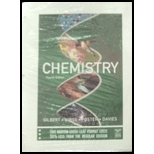
Concept explainers
(a)
Interpretation: The molecules in which phosphorus atom has an expanded valence shell is to be stated.
Concept introduction:
To determine: If phosphorus atom has an expanded valence shell in
(a)
Answer to Problem 8.98QP
Phosphorus has an expanded valence shell in
Explanation of Solution
Explanation
The atomic number of phosphorus is
The ground state electronic configuration of
The excited state electronic configuration of
The atomic number of oxygen is
The ground state electronic configuration of
The atomic number of chlorine is
The ground state electronic configuration of
There are five unpaired electrons in excited state of phosphorus due to promotion of electron to available d orbital. The unpaired electrons in oxygen is
(b)
To determine: If phosphorus atom has an expanded valence shell in
(b)
Answer to Problem 8.98QP
Phosphorus has an expanded valence shell in
Explanation of Solution
Explanation
The atomic number of phosphorus is
The ground state electronic configuration of
The excited state electronic configuration of
The atomic number of flourine is
The ground state electronic configuration of
There are five unpaired electrons in excited state of phosphorus due to promotion of electron to available d orbital. There are
(c)
To determine: If phosphorus atom has an expanded valence shell in
(c)
Answer to Problem 8.98QP
Phosphorus does not have an expanded valence shell in
Explanation of Solution
Explanation
The atomic number of phosphorus is
The ground state electronic configuration of
The atomic number of flourine is
The ground state electronic configuration of
There are three unpaired electrons in ground state of phosphorus. There are
(d)
To determine: If phosphorus atom has an expanded valence shell in
(d)
Answer to Problem 8.98QP
Phosphorus does not have an expanded valence shell in
Explanation of Solution
Explanation
The atomic number of phosphorus is
The ground state electronic configuration of
The atomic number of flourine is
The ground state electronic configuration of
There are three unpaired electrons in ground state of phosphorus.
Fluorine has one unpaired electron in its valence orbital. The two fluorine atoms will react with two unpaired electrons that are located at the
Want to see more full solutions like this?
Chapter 8 Solutions
Chemistry
 ChemistryChemistryISBN:9781305957404Author:Steven S. Zumdahl, Susan A. Zumdahl, Donald J. DeCostePublisher:Cengage Learning
ChemistryChemistryISBN:9781305957404Author:Steven S. Zumdahl, Susan A. Zumdahl, Donald J. DeCostePublisher:Cengage Learning ChemistryChemistryISBN:9781259911156Author:Raymond Chang Dr., Jason Overby ProfessorPublisher:McGraw-Hill Education
ChemistryChemistryISBN:9781259911156Author:Raymond Chang Dr., Jason Overby ProfessorPublisher:McGraw-Hill Education Principles of Instrumental AnalysisChemistryISBN:9781305577213Author:Douglas A. Skoog, F. James Holler, Stanley R. CrouchPublisher:Cengage Learning
Principles of Instrumental AnalysisChemistryISBN:9781305577213Author:Douglas A. Skoog, F. James Holler, Stanley R. CrouchPublisher:Cengage Learning Organic ChemistryChemistryISBN:9780078021558Author:Janice Gorzynski Smith Dr.Publisher:McGraw-Hill Education
Organic ChemistryChemistryISBN:9780078021558Author:Janice Gorzynski Smith Dr.Publisher:McGraw-Hill Education Chemistry: Principles and ReactionsChemistryISBN:9781305079373Author:William L. Masterton, Cecile N. HurleyPublisher:Cengage Learning
Chemistry: Principles and ReactionsChemistryISBN:9781305079373Author:William L. Masterton, Cecile N. HurleyPublisher:Cengage Learning Elementary Principles of Chemical Processes, Bind...ChemistryISBN:9781118431221Author:Richard M. Felder, Ronald W. Rousseau, Lisa G. BullardPublisher:WILEY
Elementary Principles of Chemical Processes, Bind...ChemistryISBN:9781118431221Author:Richard M. Felder, Ronald W. Rousseau, Lisa G. BullardPublisher:WILEY





